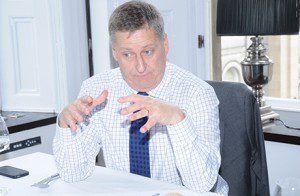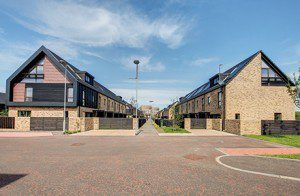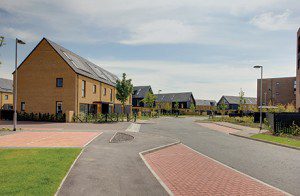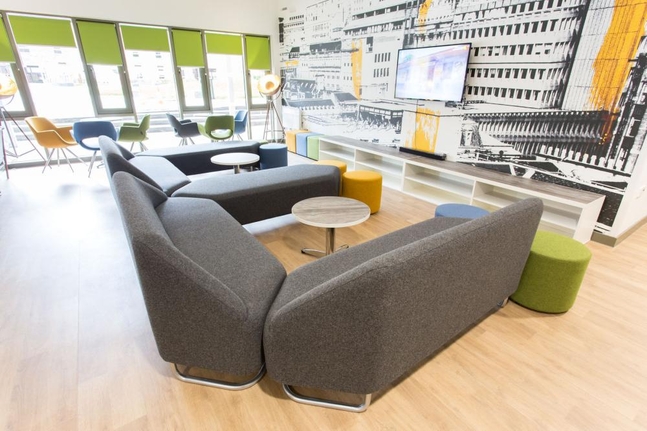On the anniversary of the Commonwealth Games, Project Scotland editor Gary Moug speaks to the key players of the City Legacy consortium which built the Athletes’ Village.
IT’S now a year since the eyes of the world fell on Glasgow as the city hosted what was described as the “standout Games in the history of the movement” by Commonwealth Games Federation chief executive Mike Hooper.
One of the major successes of Glasgow 2014 was the much-lauded Athletes’ Village in the city’s East End, which has regenerated an entire area and won more than 20 prestigious awards.
The Village hosted 6,500 athletes and officials during the event and has since been transformed into a modern residential community with 700 homes, a care home, amenities and public spaces.
Of the 700 homes, 300 are private houses and 400 are available to rent.
The Village was delivered by the City Legacy consortium, made up of CCG, Cruden, Mactaggart & Mickel Group and WH Malcolm.
The consortium was faced with the challenge of reconciling the requirements for initial use as accommodation for the two-week period of the Games, with creating a brand new neighbourhood for the East End of Glasgow to be used long after Usain Bolt et al had said their goodbyes.
The project required that the Village deliver a site average 60% carbon output reduction relative to an equivalent development which met the 2007 Building Technical Standards.
The Village actually delivers well in advance of this – a 95% carbon output reduction and all properties are approximately 35%-40% more energy-efficient than traditional Scottish homes thanks to the site’s state-of-the-art energy centre.
It was the most significant housing-led regeneration initiative anywhere in the UK at the time, with Glasgow City Council awarding the contract to City Legacy in 2009 in recognition that the consortium had the resources, skills and experience not only to work with the council to plan and build the Village, but to consider the wider picture in terms of community benefit, infrastructure impact and regeneration.
Buyers at The Village have been able to take advantage of prices ranging between £75,000 for a one-bedroom apartment to £200,000 for a four-bedroom townhouse. These are some of the most affordable new homes to be offered for sale in Glasgow in recent years, reflecting the brief to provide affordable, sustainable and energy-efficient homes that will leave a lasting legacy.
During construction, both training and employment opportunities and a wider programme of economic development initiatives served to ensure the project addressed both the imbalance of poor housing and economic wealth across the city.
The successful four-and-a-half year partnership between Glasgow City Council and City Legacy has ensured the project was delivered on time and on budget.
To date over 220 homes of the 300 private houses available for sale have been snapped up.
A third of buyers have come from the immediate local area.
On the anniversary of the Games, Project Scotland was granted exclusive access to a roundtable discussion with the four key players in the city legacy consortium:
• Ed Monaghan, Chief Executive of Mactaggart & Mickel
• John Gallacher MBE, Managing Director of Cruden Homes
• Martin Kiely, Managing Director of WH Malcolms
• Calum Murray, Director of CCG
WHAT WAS THE BRIEF?
CALUM: Primarily to create an exemplar new mixed-tenure community in the East End of Glasgow capable of first housing up to 6,500 athletes. It’s probably the only brief I’ve ever worked with where there has been no housing mix given. There was also a series of performance criteria, which posed particular risk because they were asking us back in 2009 to design to and quantify the implications of building regulations which even now are yet to come into force.
Effectively, we were being challenged to future-proof the project and to carry housing to a standard never before achieved.
MARTIN: The brief was dictated by the number of athletes and what they were looking for. Normally we’d be saying ‘What have we got to build here’. But on this project it was all about the design to suit the numbers.
ED: In theory, we could actually have delivered it all in a single tower block.
JOHN: At the outset there was a requirement for 400 social/rented houses and a care home. We had to add on to that whatever the number of houses we required to house all these athletes given the space requirements per athlete. The challenge was balancing that design requirement with the financial cost of carrying houses. You can build 1000 houses to accommodate the athletes no bother. But you’ve then got to sell them at the back end. So the trick was getting that design right and getting the ultimate carrying costs of the project right so that we didn’t all lose a fortune.
MARTIN: It would also have been so easy back then to put up half a dozen flatted blocks, similar to what they did in London for the 2012 Olympics. But in some ways, the Games were incidental. What Glasgow wanted was a legacy – a complete change to the East End. It would have been easy, in a bid sense, to go with the flatted blocks. But we didn’t because we had to come up with something which would attract people into the area, taking into account size, price and quality.
JOHN: And against the background of fixed finance. We were very much having to take a view on the cost of construction of this huge project on Day One and a) get that right, and b) knowing the fixed finance we were receiving, get the sales side of things right.
MARTIN: People kept comparing the task with the London Olympics but the projects were so far apart. The world fell off a cliff in London for a week-and-a-half. We were building, in the East End of Glasgow, a full regeneration. When you consider people pay in London £250,000 for a cupboard, it’s a totally different market to what we were doing. They were poles apart so you can’t compare the London Olympics Village with the Glasgow Commonwealth Village. To a great extent, we had a much harder task. Unlike London, we were also on a very finite amount of money.
CALUM: Added to which, It was the only regeneration project, at the time and probably still, which had private money in it – ours !

WHAT CHALLENGES DOES WORKING TOWARDS A FIXED DEADLINE CREATE?
CALUM: It’s not just the contractual implications of failure we had to contend with but the fact that, rather uniquely, we had 6,500 athletes coming from all over the world to descend on our project, to live in it.
JOHN: I never had any real concerns about our collective ability to physically deliver the project on time. The big question was whether we could get all the statutory consents lined up to happen when we needed them to keep the project moving.
CALUM: In this regard, one piece of advice we got from the project managers of the Athletes’ Village in London was that if we wanted to make the target absolute, don’t innovate. Yet here we were delivering housing standards that were yet to be drafted, so this advice completely contradicted what we were being asked to do by Glasgow and hence posed a significant risk and threat to delivery.
ED: Also, CHP had never been done in the modern era on that scale either so that challenged us a fair bit and caused some sleepless nights worrying about how the private sales market would receive this. It was all little micro deadlines as we headed towards the big one. But John’s right – 6-9 months out, maybe even longer than that, we had no fear about the delivery of it, which was reassuring because on these big projects you hear stories about them all going to the wire. We were pretty relaxed in that regard.
JOHN: I would actually go further than that. Our obligatory handover date was January 2014. We met that, but we thought that was far too early. They could have made it April. They wanted it early so they could do subsequent work like communications, security and infrastructure. So the Organising Committee gave themselves more than enough time.
WHAT ABOUT THE CHALLENGE OF WORKING AS A CONSORTIUM?
ED: I always say one of the great things about this consortium goes back to the overall timetable and that is the drop dead date or, as I call it, jeopardy. That was the great thing because as much as you inevitably get pulled and prodded in your own business about priorities, in this project there was only one date we had to work to. So whether we felt we were going too fast or too slow, we were all working to the same date. I always say now in any consortium – and I’m involved in half a dozen – is that if we all had that level of jeopardy we’d certainly get on far better. Individual businesses have individual priorities. This project could only have the one priority.
JOHN: Ed’s absolutely right in terms of the timescale. We’ve all worked on various consortiums at different times. Usually what happens is common working and then you split up to do the private part of the sale or whatever. But this project was absolutely a partnership. We were all in for the same amount of money and the same amount of risk. What also became very clear within ten minutes of being awarded the project was that there was no way you could be involved in every single aspect of the delivery, so you were very much relying on your partners, which I don’t think we’ve ever done to the extent we did here.
MARTIN: I think, particularly the four of us as individuals, we bonded really well and we’re all quite close. It’s like our own wee mini company. It was more than just the jeopardy thing, the four of us realised early on that with the world watching, this had to be right. It wasn’t just the jeopardy of the finance, it was our whole reputation, and Glasgow and Scotland’s reputation, that was at stake.
JOHN: It was good to get a situation where all the big PLCs were out of the game. It was just four west of Scotland-based companies delivering against the most difficult market we’d ever seen in our lives – and we’ve done it.
CALUM: The prestigious awards this project has won speak for themselves. We won a Saltire Award last year, which was a huge accolade and quality marque. We also won the RTPI’s planning award – in fact we won pretty much every award we put in for. This consortium has delivered and more!

WHAT IS THE LEGACY OF THE VILLAGE?
ED: I think it’s transformational. The scale, the size, the location. I don’t think we could have delivered it without the momentum of the Games. It was a unique opportunity where lots of things came together. The East End’s got a long way to go. We coined the phrase early in the process ‘If not now, when?’ for the East End, because you couldn’t get a perfect storm of ideas all coming together. There have been many false starts in the area. I think this is just the start.
CALUM: The sales success is the biggest tribute you can pay it. We’re now sitting in excess of 200 sales so the Village has passed the acid test. If you take something to the market and people don’t buy it, you’ve failed. People now want to return to the East End.
JOHN: The other thing which is interesting is that on Day One we stated during our presentation that we felt, given the number of houses we were building in this part of Glasgow, it was essential that a primary school be built. We were told at the time this wasn’t our problem. Of course, it’s now come full circle. In Phase 2 there will be a primary school and a nursery. It shows that we had it right, we knew what we were talking about. Getting people to listen is difficult sometimes. But if you’re remodeling an area, this is one of the essentials.
MARTIN: I think it’s fair to say that the level of satisfaction has been phenomenal. The athletes were full of praise, the coverage of the Village was superb. A lot of the athletes said it was the best Village they’d ever stayed in.
ED: A lot of the athletes had experience of multi-level accommodation from other events they’d been at. We had low-rise housing with front and back doors and gardens. We were all guests at the opening ceremony and to get into the stadium you had to take a long way for a shortcut. You walked around half the East End to get to Celtic Park and I remember looking right down Springfield Road and I was genuinely proud of what we’d achieved. You could see the Village and every single window was open because it was so warm. To think we’d built the place where all the athletes were staying – I couldn’t have been prouder.
MARTIN: To a great extent, the Village more than anything has been the catalyst for the regeneration of the East End . You can regenerate all you want, but without people it means nothing. Attracting in people to something like the Village brings life to it. There is, and always will be in my opinion, a lasting legacy.
CALUM: I was at the Village with some Chinese visitors recently and they were blown away by it – the quality, the housing and the scale of it. This project has had an international impact.

DID YOU ENGAGE WITH THE LOCAL COMMUNITY DURING THE DEVELOPMENT PROCESS?
CALUM: Yes, starting at the front end of the planning process. We had an application which was of national importance. There was an intense three-month period of public consultation and on-going stakeholder management.
ED: I remember making a presentation early on. I was armed with so many facts about the Village that my head was bursting. The local community was there and there was a Q&A session where people could ask anything. Some primary school kids were there and one of them stuck his hand up. I thought this would be an easy question… ‘How many play areas are there?’ he asked. Nobody had briefed me on the play areas! Thankfully the architect was in the audience and was able to provide an answer. But yes, we met the community many, many times.
CALUM: Equally, we all had and have an affinity with the area. Cruden and CCG are based in the East End. Martin and Ed are from the East End.
MARTIN: I actually played football for Dalmarnock amateurs for two-and-a-half seasons. The football pitch we ripped up was our home pitch. That was our home ground we built the Village on. So yes, there is a local affinity. We know a lot of people there and the majority were very supportive of us.
CALUM: A week before the handover, I met a woman who stayed in a house right across from Gate 5. There had been barriers around the site, with work going on for over four years. Prior to that, the community had experienced all the demolition and clearance work that had gone on beforehand – huge amounts of inconvenience. This woman turned to me and asked if we were leaving the fences up. I thought she meant fences to the plot-works but she meant the fences and gates around the site! Only then did I truly realise how disenfranchised the community had become from what we were building.
HOW IMPORTANT WAS THIS PROJECT FOR THE SCOTTISH CONSTRUCTION INDUSTRY?
MARTIN: It was crucial and kept people in jobs. It kept Scottish companies with Scottish workforces in employment.
CALUM: The site at it’s peak employed in excess of 700 people and created aside 144 work placements and 89 apprenticeships. The external benefits across Glasgow must have been colossal. So many small businesses benefited, from metal workers to painters and decorators.
ED: It brought a bit of kudos as well. People enjoyed being a part of it. The closer we got to the Games actually opening, the more people wanted to be associated with it. I stuck around Glasgow for a week during the Games as my summer holiday last year. There was a real buzz, Glasgow genuinely wanted this to succeed. This wasn’t a Games where people wanted to get out of town because it would be too busy. Everyone wanted to be part of it.
JOHN: We’ve been involved in this project for six years and the guys sitting around this table are the same four guys. There isn’t any other organisation involved in this process with the same individuals. Over the piece, we had significant personnel changes on other sides. Anyone stepping into this project at senior level has a learning curve. There was a natural slowness, if you like, at times when it came to getting a decision. Things like that were happening intermittently. We just kept our heads down and kept going.
WHAT IMPACT HAS BEING PART OF THIS PROCESS HAD ON YOUR INDIVIDUAL COMPANIES?
CALUM: One of the biggest management challenges for us was eliminating complacency within the business. Having won the Games, it was important to realise this wouldn’t fix everything in the middle of the recession. It was deliberately played down in our organisation and our people were necessarily asked to look beyond and towards the next project.
MARTIN: We are four very distinct, high-reputation businesses. It was about proving we could do it. This was something Glasgow was doing and we wanted to do our bit. It was never about what we’d get on the back of it.
ED: I agree entirely with that point, but it did bring great pride to our organisation. People really wanted to be part of it and would ask on our sites what the chances were of getting to the Athletes’ Village. At a point when times were hard, it was a little shot in the arm to be part of something that was unique.
When you’re in the middle of it all, sometimes you fail to recognise the uniqueness. So there are lots of little spin-off benefits. Probably few of them appear on the bottom line, but hopefully it makes your business better, stronger and people more engaged.
MARTIN: If there’s one job we’ll look back on in our careers, without a shadow of a doubt, it will be the Athletes’ Village.
HOW BIG A JOB WAS THE RETROFIT AFTER THE GAMES?
ED: One of the things we spent time on was minimising the retrofit at the back end, through the design process. That was a hard shift because the Commonwealth Games Committee had a criteria for how Athletes’ Villages and accommodation operates – certain square meterage for each athlete, access to toilets/showering, and all of that. So we had to work out how we could provide that without having to go back in and knock seven bells out of the place.
We were planning on using the kitchen and lounge for sleeping accommodation because there was no requirement as such for those particular uses during the Games.
We had to do some partition removing afterwards but in the main, what the athletes’ got was then what we were passing on. The homes were already wired and plumbed.
CALUM: It was a colossal challenge at the time. We had to take the site back to a saleable environment so there was a huge amount of activity. That we achieved our key target dates, particularly on the delivery of the affordable housing, is an immense tribute to the construction teams and the guys on site.
MARTIN: You’ve got to remember as well that when we started, we physically couldn’t guarantee a sale because it was too far back. We had people committing to buy but, legally, couldn’t guarantee anything. We had all that pressure after the Games. It was monumental what we did. Crucially, If we hadn’t put the thought and effort in the years before, then it would have been an even bigger challenge.
ED: You can tell we still on get on. Genuinely, it has fostered friendships beyond business. It was a difficult project, in difficult circumstances and a difficult timeline. We all worked together and we all got the best out of it.













